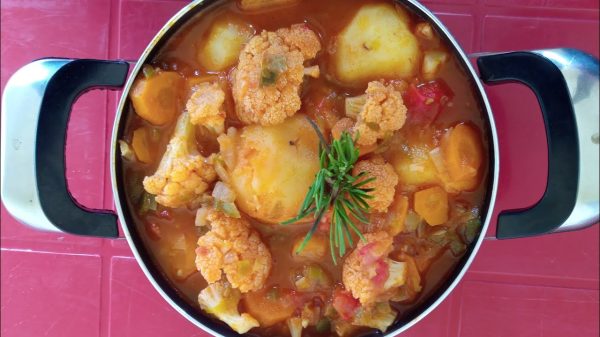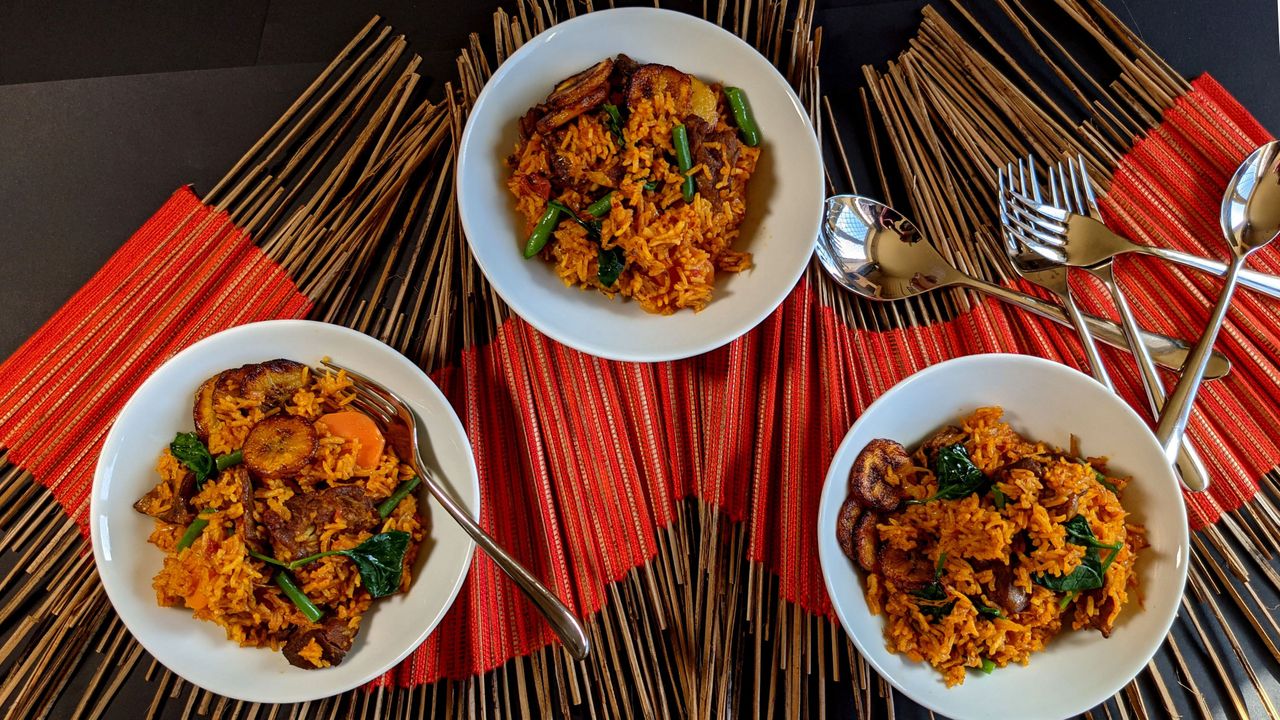Nigeria’s culinary landscape is a vibrant tapestry woven from the threads of its over 70 distinct ethnic groups, each contributing unique flavors, traditions, and stories to the nation’s rich cultural heritage.
Food in Nigeria is far more than sustenance—it is a celebration of community, a manifestation of history, and an expression of identity. As you explore the country’s diverse cuisine, you embark on a delicious journey that unravels the very essence of Nigerian life, from everyday meals to special festive occasions. In this article, we delve into ten popular Nigerian foods everyone should try, uncovering their key ingredients, traditional preparation methods, and the cultural significance that makes them so beloved across the nation.
1. Jollof Rice
Often hailed as the undisputed king of Nigerian cuisine, Jollof rice is a cornerstone of West African culinary traditions. This one-pot dish is famed for its vibrant reddish hue, derived from a rich, tomato-based sauce. The secret behind its unforgettable taste lies in the careful blend of fresh tomatoes, bell peppers, onions, and an aromatic medley of spices, including the fiery Scotch bonnet peppers that lend a signature heat. Traditionally prepared over open flames, Jollof rice develops a coveted smoky undertone as the rice caramelizes slightly at the bottom of the pot. It is commonly served with a variety of sides such as fried plantains, grilled chicken, or fish, making it a versatile dish that adapts to many regional palates. The friendly rivalries among West African nations over who makes the best Jollof are a testament to its cultural significance and enduring popularity.
2. Pounded Yam and Egusi Soup
No discussion of Nigerian cuisine would be complete without mentioning the classic pairing of pounded yam and egusi soup. Pounded yam is a smooth, stretchy dough-like dish made by boiling yam until tender and then pounding it to a perfect, lump-free consistency. Known by different names across ethnic groups—Ìyàn among the Yoruba, Sakwara in Hausa, and Utara-ji in Igbo—this staple is revered for its unique texture and ability to act as the ideal “swallow” for rich soups.
Egusi soup, on the other hand, is a hearty stew made primarily from ground melon seeds (egusi), which serve as a natural thickening agent. The soup is enriched with an array of ingredients including leafy vegetables (often bitter leaf or spinach), assorted meats such as beef, goat, or smoked poultry, and even seafood like fish or crayfish. The process begins with grinding the egusi seeds into a fine powder, which is then cooked in a savory stock flavored with onions, tomatoes, and peppers. A generous splash of palm oil imparts a vibrant color and rich flavor to the dish. Traditionally served with pounded yam or other starchy swallows like fufu or eba, this combination not only satiates hunger but also nurtures a sense of familial and communal unity. Passed down through generations, the preparation methods of pounded yam and egusi soup encapsulate centuries of culinary heritage, symbolizing fertility, prosperity, and the joy of shared meals during celebrations and family reunions.
3. Suya
Hailing from the Hausa regions of Nigeria, suya is the country’s take on the beloved kebab, offering a street food experience that is as flavorful as it is iconic. Suya consists of thinly sliced beef, chicken, or ram that is skewered and generously coated in a peanut-based spice mix known as yaji. This spice blend, rich in flavor and heat, gives suya its signature taste that is both smoky and spicy. Typically served with fresh slices of onions, tomatoes, and a drizzle of spicy pepper sauce, suya is a favorite among locals and visitors alike. Its popularity on the streets of Nigeria speaks volumes about its irresistible appeal, making it a must-try for anyone eager to sample authentic Nigerian flavors.
4. Moi Moi
Moi Moi is a protein-rich steamed bean pudding that offers a delightful contrast to Nigeria’s more robust dishes. Made from peeled black-eyed peas blended with onions, peppers, and a mix of spices, this soft and moist delicacy can be enjoyed as a side dish or as a meal in its own right. Often, moi moi is enriched with additional ingredients such as boiled eggs, fish, or corned beef, further elevating its flavor and nutritional value. Its smooth, pudding-like texture and savory profile make it a popular choice at parties and family gatherings, where it serves not only as a tasty treat but also as a symbol of the culinary creativity inherent in Nigerian cooking.
5. Pepper Soup
True to its name, Nigerian pepper soup is a fiery, aromatic broth that packs a punch both in flavor and in its traditional medicinal value. Prepared with a blend of indigenous spices and generous amounts of chili peppers, this broth is typically cooked with assorted meats such as goat, fish, or chicken. The vibrant and intense flavors of pepper soup make it a popular appetizer, while its reputation as a remedy for colds and other ailments adds to its cultural allure. Whether enjoyed as a starter or a light meal, pepper soup exemplifies the bold and spirited character of Nigerian cuisine.
6. Akara
Akara, deep-fried bean fritters, are a quintessential part of Nigerian breakfast culture. Made from a batter of peeled black-eyed peas, onions, and spices, these fritters are perfectly crispy on the outside while remaining light and fluffy on the inside. Often served with pap (a fermented corn pudding) or bread, akara is not only a convenient street snack but also a beloved homemade treat. Its popularity, especially among the Yoruba people, highlights the importance of simple, yet flavorful, foods in Nigerian daily life. Whether sold by street vendors or prepared at home, akara represents the communal and accessible spirit of Nigerian culinary traditions.
7. Efo Riro
Efo Riro is a rich and nutritious vegetable stew that holds a special place in the heart of Yoruba cuisine. The dish primarily features leafy greens—most commonly spinach or cockscomb amaranth—cooked in a robust peppery tomato sauce. The sauce, made from a blend of tomatoes, onions, and bell peppers, is often spiked with Scotch bonnet peppers for an added fiery kick. Enriched with proteins such as beef, chicken, offal, or smoked fish, Efo Riro transforms simple vegetables into a hearty, satisfying meal. Its preparation involves blanching the greens to preserve their vibrant color and nutrients before gently incorporating them into the simmering sauce. Beyond its taste, Efo Riro is celebrated as a symbol of hospitality and culinary expertise, often served at family gatherings and special events, and is best enjoyed with a side of pounded yam, fufu, or rice.
8. Boli
Boli, or roasted plantains, is a testament to the simplicity and versatility of Nigerian street food. This beloved snack is prepared by roasting ripe plantains over an open flame until they become caramelized with a slight char, which enhances their natural sweetness with a smoky flavor. Frequently served with groundnut (peanut) sauce or a spicy pepper sauce garnished with fried or roast fish, boli is a favorite among locals, particularly in southern Nigeria. Its ease of preparation and delectable taste make it a popular choice for a quick bite on the go, offering a perfect blend of sweetness and smokiness that captures the essence of Nigerian casual dining.
9. Ofada Rice and Ayamase Sauce
Ofada rice, a locally grown Nigerian variety, is known for its distinctive aroma and slightly sticky texture. Unlike the long-grain varieties commonly used in international recipes, Ofada rice carries an earthy, robust flavor that is uniquely its own. Traditionally served with Ayamase sauce—often dubbed “designer stew”—this combination creates a flavor profile that is both rich and complex. Ayamase is a spicy green pepper sauce made from green bell peppers, onions, and assorted meats, lending a deep, satisfying spice to the dish. This pairing not only highlights the local ingredients of Nigeria but also showcases the innovative spirit of Nigerian cooking, blending tradition with a modern twist to produce an unforgettable taste experience.
10. Banga Soup
Originating from the Niger Delta region, Banga soup is a deeply flavorful specialty cherished by the Urhobo and Itsekiri people. Its foundation lies in the rich extract of palm nut, known as banga, which imparts a creamy texture and a unique, slightly earthy taste to the soup. The dish is traditionally seasoned with an assortment of indigenous spices—such as oburunbebe stick, beletete, ataiko, and irugeje—that together create a complex aroma and flavor profile. Banga soup is typically enriched with proteins like fresh catfish, tender goat meat, or other varieties of meat and seafood, and is often finished with the addition of bitter or scent leaves that balance its richness. For many in the Niger Delta, Banga soup is not just a meal but a culinary emblem of cultural identity, commonly served during social events, traditional ceremonies, and family gatherings. Often enjoyed with a starchy accompaniment such as usi—a sticky, yellow dough-like substance made from cassava—or eba made from garri, Banga soup captures the soul of its region and evokes nostalgic memories for those far from home.
Subscribe to our Newsletter
Stay updated with the latest trends in African Pop Culture!























